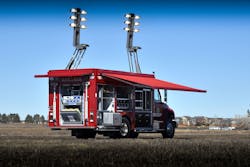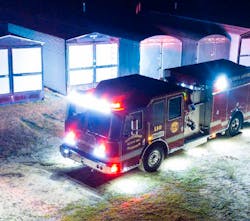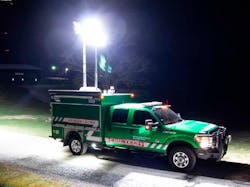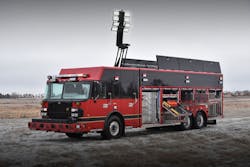Focus on Scene Lighting Shifts From Brightness to Efficiency
When it comes to scene lighting, humans have created devices that can replicate the Sun. Fire apparatus scene lighting is no longer focused on trying to make brighter lights. Rather, the focus has shifted to best placement, efficiency and durability.
With the evolution of light emitting diode (LED) technology, lighting fixtures today are almost too bright for most emergency scenes, and the pursuit of higher candlepower and more lumens has slowed.
“As a lighting industry, we’ve been focused on how do we make it brighter,” said Sam Massa, president and chief technologist for HiViz Lighting/ FireTech, a lighting manufacturer in Hendersonville, NC. “We’re no longer trying to inches up the lumens. We’re no longer in a race to the top of the heap for the most lumens. … Lighting can now get smarter, better placed and more reliable.”
Roger Weinmeister, president of Command Light, a light tower and scene lighting company based in Fort Collins, CO, agreed.
“LEDs are not really the new thing in scene lighting any longer,” Weinmeister said. “They are super bright and everybody’s got them. …I think what the new thing is getting them located at the right place and angle so they don’t cause you problems.”
That’s why Weinmeister, whose company makes light towers, believes it’s best to have the lighting source be elevated.
Elevated Lighting
“We evolved with the Sun over our heads and that’s why we have eyebrows that allow us to see in the distance,” Weinmeister said, adding that helmets, ball caps and even foreheads are all designed to keep glaring light out of our eyes.
When firefighters and first responders are working on dumping water at a fire scene or retrieving the victim of a rollover crash down over a bank, having the light overhead is ideal, Weinmeister said.
“It’s not only better for you, it puts the light where it is needed and it can contrast the topography and go down in a ditch,” Weinmeister said.
Massa believes scene light “is going to get a lot smarter.”
“We will be able to use data off the fire apparatus to make real-world determinations about the shape, color, position, and intensity of the fixtures,” Massa said. “The whole point is to reduce the amount of thinking and manual interactions the firefighters need to do with the truck and the fixtures to create a safe, effective, after-hours work light zone near the apparatus.”
Brighter is not Better
Massa, who is a firefighter with Mills River, NC, Fire & Rescue, said the most important think about scene lighting is to have it where it is needed with the right intensity. Brighter is not always better, he said.
“We are literally tethered to the apparatus by the crosslay or the booster line,” Massa said, noting that apparatus scene lights that can illuminate thousands of feet, or even miles, make no sense for the fire service.
HiViz/FireTech has its roots in the mining industry where lights are mounted on gigantic equipment, with booms 60 feet in the air, Massa said, adding that the company believes it is “king of lumens” making among the brightest scene lights available.
But, Massa said, that doesn’t do firefighters any good. What is more important is the evenness of the illumination and the minimizing of the bright pulses and hot spots to the dark sky.
“There’s a whole science involving optical fatigue,” Massa said, adding that includes minimizing the number of times responders traverse areas of high to low intensity lighting.
“As firefighters walk around an apparatus, you don’t want areas of high to low lighting and the way to do that id to have a greater number of fixtures with less intensity and an even beam pattern,” Massa said.
Preserving Night Vision
Weinmeister stressed the importance of “preserving” responders’ night vision by avoiding blinding direct light.
“I am a tower guy,” Weinmeister said. “These are the other legs of the milk stool seen as good lighting for night scenes.”
With bright warning lights and bright scene lights, Weinmeister said responders are not only blinded, but motorists and the public are blinded as well.
“We are overwhelming their brains with brightness,” Weinmeister said.
Weinmeister said Command Light has developed a new product called the OctoLight which features eight light heads producing scene lighting as bright as stadium lighting.
He said the heads can be rotated to not only put lighting where it’s needed, but also to elevate it to emulate sunlight.
“It gets a lot of lights up in the air,” Weinmeister said. He added that it also increases the efficiencies of LED lights by allowing them to be aimed.
“It provides as much light as you’re going to need to cover a large scene,” Weinmeister said, adding that the light heads can provide back lighting as well.
“You are paying for all those LEDs, you should make sure you can use them all,” he said.
Massa also agrees with placing lights where they are needed the most. That’s why he recommends responders think about their scene lighting needs while specifying their apparatus.
He said HiViz/FireTech will help responders select lighting and placement before the apparatus is built as a free service.
“There’s a lot of planning that goes into lighting and there’s no cost to planning,” Massa said. “We can help [customers] pick a fixture and a location.”
For Massa, the thing that matters most when it comes to scene lighting is to illuminate the area where responders are working.
“More ambient lighting is more efficient,” Massa said. “All around lighting is most advantageous. …Imagine going to a fire with a blind fold on, or your hood on backwards. You can’t do anything. No other tool is useful unless you can see.”
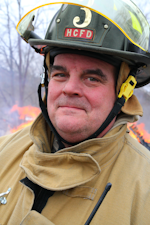
Ed Ballam
Ed Ballam served as associate editor for Firehouse. He is the assistant chief of the Haverhill Corner, N.H. Fire Department, and a National Registered EMT. He is also a Deputy Forest Fire Warden for the New Hampshire Division of Forests and Lands. Professionally, he's been a journalist for over 35 years working for a variety of publications, including employment as managing editor of a national fire service trade journal for more than a decade.
